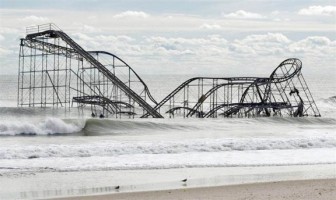NEW YORK, (Reuters) – While superstorm Sandy sent most people running for shelter wherever they could find it, bird enthusiasts rushed outdoors as soon as possible to scan the skies for birds that usually don’t visit these parts.

A powerful storm can take birds far from home or thousands of miles off their migratory course if they are swept up in the center of a storm and carried along until they reach the first spot where it is safe to land.
To greet them, there are often groups of intrepid bird watchers, or birders, eager to spot an extremely rare out-of-town visitor like the Leach’s Storm-Petrel.
Birders were quick to say on Friday that they were very upset by the devastation caused by Sandy, which killed scores of people, ruined homes and left many without power. But they also view dangerous storms as an opportunity.
Because the storm that ravaged the U.S. Northeast this week combined a hurricane from the south and winter winds from the north, it brought in a more peculiar group of birds than usual when it made landfall in New Jersey on Monday night.
“This was a storm that mixed species groups you don’t ever usually see together,” said Andrew Farnsworth, a New York-based researcher for Cornell University’s Lab of Ornithology.
One birder discovered a Red-billed Tropicbird in New Jersey – more typically seen in the Caribbean – and brought it to a wild-life rehabilitator, according to Farnsworth, who studies reports on the online forum ebird.org.
Near Ithaca in Upstate New York, one ebird.org visitor reported seeing an arctic bird, the Ross’s Gull, while another reported a sighting of the same bird near Lake Ontario, Canada.
“The same storm that brought this arctic bird also brought this Caribbean bird,” said Farnsworth, 39.
On Tuesday, as soon as they decided it was safe to go outside, several Manhattan birders headed to the banks of the Hudson River. They were delighted to catch sight of Jaegers, which are typically only found out at sea.
“It’s just exciting to be on the Hudson and see these birds that you’d normally only see out on a fishing boat,” said Dale Dancis, a retired teacher who declined to disclose her age.
Starr Saphir, 73, who leads bird tours in Central Park and appeared in a HBO birding documentary, “The Central Park Effect,” said she saw Forster’s Tern on Tuesday. “They had already migrated south so they got blown back,” she said.
Peter Post, 73, a retired social services worker who has been a birder for 62 years, said he spotted an American Oyster Catcher on the Hudson, far from its coastal habitat.
Post was disappointed he missed the Leach’s Storm-Petrel Farnsworth spotted on Tuesday. “It would’ve been nice,” he said.
Joseph DiCostanzo, 60, an ornithologist who works at the American Museum of Natural History, was lucky enough to see a Red Phalarope, usually an ocean bird, near the river through the window of his Manhattan home before he was able to go outside.






